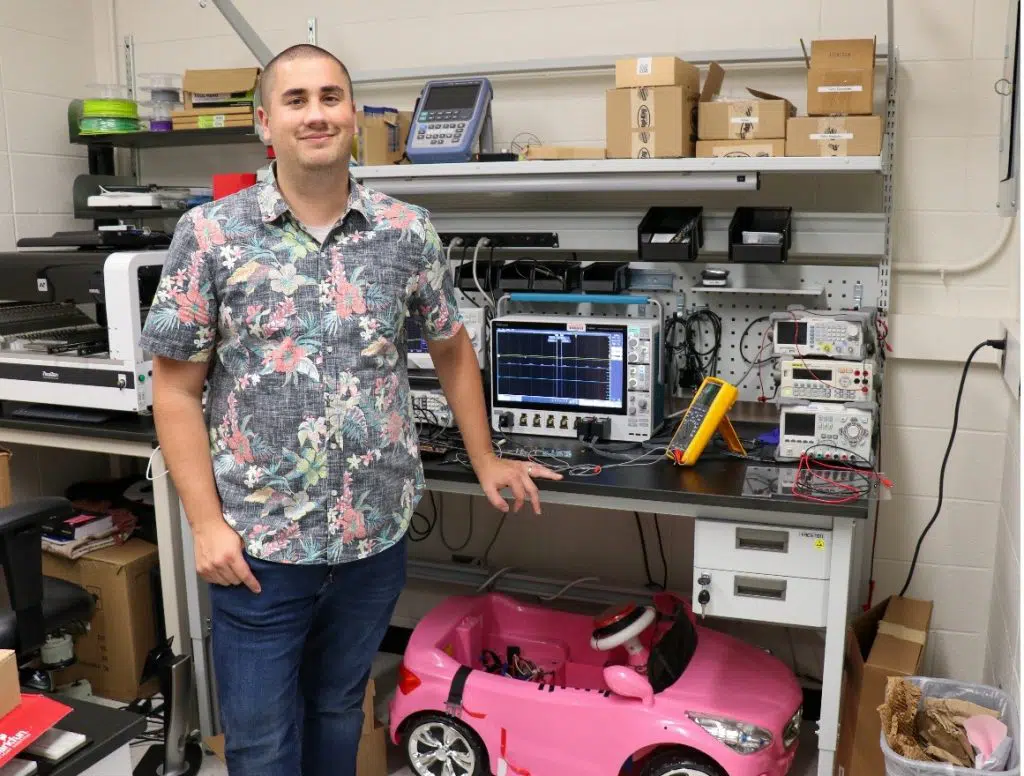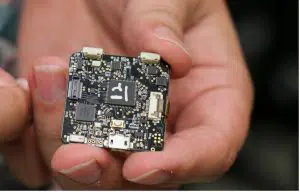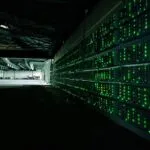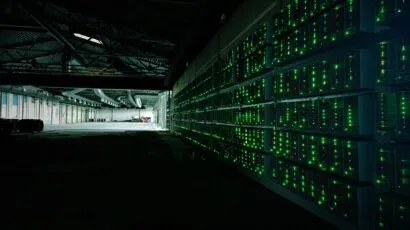No battery? That’s no problem for the future Internet of Things
By Christian Elliott | November 3, 2021
 Josiah Hester stands in front of a circuit board printer and RF analyzer in Ka Moamoa's lab space. The pink car under the table is part of the lab's Go Baby Go! program that turns battery cars into power wheelchairs for children with cerebral palsy.
Josiah Hester stands in front of a circuit board printer and RF analyzer in Ka Moamoa's lab space. The pink car under the table is part of the lab's Go Baby Go! program that turns battery cars into power wheelchairs for children with cerebral palsy.
Computer engineer Josiah Hester is outside a Latin American street food restaurant in Evanston, Illinois, with four of his computer science graduate students, talking above the rumble of an El train as it passes overhead, sweating in his Hawaiian shirt, and waiting for the bag of burritos he’s bought them. As they wait, he quizzes the students about ShotSpotter, the controversial tech company that the city of Chicago hired to monitor violence on the city’s South Side with hidden microphones that locate gunshots via triangulation.
Hester points out that the system has serious flaws: It sometimes misclassifies fireworks as gunshots; the accuracy of the microphones can be affected by raindrops; and employees could, in theory, edit the system’s backend code at the request of police, changing where a shot was detected.
“So how could we audit that type of technology, if they wouldn’t give you any code, and their sensors are hidden?” he asks.
The students begin theorizing about how ShotSpotter works; is it really machine learning, or “just a bunch of MATLAB scripts doing signal processing?” Are the signals travelling via cell tower, or unencrypted ISM 915-megahertz radio signals? Is the triangulation calculated using time difference of arrival?
“You could make some sort of open-source, open-access replication of ShotSpotter with a bunch of energy harvesting microphones all over the place and say, “this is what we’re doing, it’s the same thing the city’s doing but with accountability,” says John Mamish, one of Hester’s doctoral students.
Hester nods his approval. To a non-computer scientist, the details of this impromptu debate might seem geeky, but the implications are important. How can society ensure that new technologies are equitable and have a net positive impact on society? “I view technology, in the best case, as a type of equalizing force,” says Hester, an assistant professor of computer science and electrical and computer engineering at Northwestern University. “But it’s been used as a force for evil. So someone else has to push back. And that’s what we’re trying to do.”
A native Hawaiian, Hester runs an applied research center at Northwestern called the Ka Moamoa Ubiquitous and Mobile Computing Lab; it focuses on the sustainable future of computing. Hester established the lab in 2017 and named it for the moamoa, a small spot at the end of a traditional Hawaiian voyaging canoe where the guiding spirit, or akua, sits.
Hester wants the science his lab does to be a guiding spirit for society, to challenge established norms and show decisionmakers “here are the types of things we could be building, could be doing,” he says. “We try to have more of an indigenous Native mindset and let that guide the applications.”
Burritos in hand, the students walk back to the campus lab to continue this mission by working on Hester’s specialty: sustainable alternative power sources that could replace batteries—and eliminate or reduce the many negative environmental impacts of battery use in the avalanche of electronic consumer and research devices pouring into everyday life.
A battery of environmental problems. Experts have forecast that by 2035, over a trillion connected devices will make up the so-called Internet of Things. All those devices will need power, and batteries are an incredibly environmentally destructive energy source. The mining of lithium—a key element in today’s rechargeable batteries—uses excessive amounts of water and, in some cases, has displaced indigenous tribes whose members live on top of the valuable resource. Also, when batteries die, they leach toxins into and out of the municipal landfills where they too often wind up.
“If you only care about profit, of course you’re gonna just go for the battery,” Hester says. Historically, that’s what capitalism has chosen—the easiest, cheapest option. Hester wants people to ask, “Why was this the default?”
Now, Hester says he’s seeing a sea change brought on by the urgency of the climate crisis—an “explosion of interest” and funding support for his alternative solution: tiny, ubiquitous, long-lasting, energy-harvesting sensors and computing devices that don’t need batteries.
But eliminating those little bottles of lithium comes with tradeoffs—the capacitors and supercapacitors that replace them store much smaller volumes of energy. Devices running on capacitors can’t operate for long periods of time without losing power.
Hester’s field, called “intermittent computing,” attempts to solve that problem. The ultra-low power devices he builds—including a prototype batteryless Gameboy powered by the game’s button presses plus solar energy—must be able save what they’re doing in milliseconds when they lose power and restart instantly when they get more juice. That requires innovations such as operating systems and software that can handle frequent power losses, new types of non-volatile memory, low-power screens, and innovative new ways to generate energy.
Hester calls the Gameboy project an example of “design provocation,” a way to encourage the development of new and creative solutions to big problems. “You do things like the Gameboy like, ‘look, this is possible.’ Because the general population just has no idea that this is possible. They just accept, as the default, batteries. So, you show them a different way.”
The lab’s work has applications far beyond videogames, especially in settings where battery power is impractical—medical devices embedded in the human body, or sensors in roadway pavement that monitor traffic and are powered by the vibrations of cars passing above.
One current collaborative project with Northwestern environmental engineers involves computers powered by microbes in the soil. These geo-bacteria assemble around electrodes and generate “a trickle of infinite endless drops” (microwatts) of electricity to power sensors that can measure and transmit data about soil health—moisture, carbon sequestration, chemicals, and so on. The work is funded by a $1.2 million interdisciplinary National Science Foundation grant.
“What Josiah is especially good at is collaborating with other people,” Mamish says. “He’s a very social guy on a personal and scientific level.”
The “whoa” of mobile computing. Hester didn’t necessarily expect he’d end up an award-winning scientist running a sustainable computing lab at Northwestern. But growing up, he says, “there was direct contact with computers at all points in my life.” For his parents, who started an enterprise IT business in the early 1990s, computer science “was like a get out of poverty now card, guaranteed money.” His family had struggled after his grandmother left Hawaii following US annexation and moved to North Carolina.
Until college, Hester treated computers as a hobby, reading books about Java programming and making video games. Then he took a course on mobile computing at Clemson University, expecting to work on cell phone programming for easy credits. But his professor started the class by holding up a printed circuit board he called a mote—a small but powerful wireless sensor that could collect data from its environment and transmit it across distances for use in scientific research projects—and saying, “this is mobile computing.”
Hester was hooked: “I was like ‘Whoa, that’s cool.’ I never connected that computing in the virtual world could be strongly connected to the physical world.” Since then, he hasn’t looked back. He stayed at Clemson for his Ph.D., then landed a position at Northwestern and started Ka Moamoa. Mamish was his first recruit. Four years later, the lab has 14 members and is expanding quickly.
Of smart watches and pink electric cars. Mamish pulls up code and images on his office computer related to a tiny wearable camera Hester’s lab is developing for Northwestern’s Health Aware Bits (or HABits) preventive medicine lab; the camera will be used to study how patterns of behavior perpetuate health issues like obesity. The quarter-sized device uses thermal imaging to detect whether the wearer is smoking or eating while obfuscating everything in the background with an algorithm, maintaining the wearer’s privacy. Despite filming and transmitting constantly, the small device has a 20-hour battery life.

Nabil Alshurafa, an assistant professor of preventive medicine and computer science, heads up the HABits lab at Northwestern’s Feinberg School of Medicine. He served on the faculty committee that interviewed and hired Hester four years ago. “I think the thing about collaboration is you want to see that this is someone you would enjoy working with.” Alshurafa says, “And that was something that Josiah and I felt immediately.”
Alshurafa says their research interests are complementary. Hester has the hardware expertise to build energy efficient wearable devices. Alshurafda, meanwhile, has the experience with software and research methods to analyze the data those devices collect.
Hester’s small lab space in Northwestern’s labyrinthian limestone Technological Institute building is packed with evidence of projects in progress. On one lab table, jagged lines scroll across the screen of a radio frequency (RF) analyzer that can pick up Bluetooth signals. Nearby are several printed circuit boards. Hester picks up a tiny board with an LCD screen; it’s an Amulet smartwatch, a health monitoring device that runs nine months on a single charge.
Across the table is a “robot that builds other robots,” Hester jokes. It’s a printer that researchers can use to create custom printed circuit boards. Under another lab table is a child-size bright pink electric car from the lab’s “Go Baby Go!” program; it can serve as a makeshift power wheelchair for a child who can’t afford the real thing. The cars also measure and transmit mobility data to the child’s physical therapist.
How we got here. Intermittent computing dates to 2007 when computer scientists Emery Berger and Jacob Sorber (later Hester’s Ph.D. advisor) at UMass Amherst created Eon, an “energy-aware” programming language for what they called “perpetual computing”—a theoretical battery-powered system that was able to conserve energy over long periods of time and tolerate occasional power failures and recharging periods.
In 2011, software engineer Ben Ransford and Sorber built on Eon, writing one of the first papers on batteryless intermittently operating systems: “Mementos: System Support for Long-Running Computation on RFID-Scale Devices.” In the Christopher Nolan thriller Memento, the protagonist suffers from amnesia and tattoos memories he knows he’ll forget on his skin. Based on energy harvesting radio wave-powered Intel chips called WISP devices, Ransford’s software system Mementos worked similarly. It allowed programmers for the first time to easily break their programs into “checkpoints” that save execution progress in the face of frequent power failures over short periods of time. Mementos eliminated the need for programmers to think about managing the system’s energy themselves. That paper got computer scientists excited about the fledgling field’s possibilities.
“The wonderful thing about energy harvesting is that once you have this mindset that energy can be gathered and harvested, you start to see opportunities everywhere,” Ransford said.
In 2014, computer scientist Brandon Lucia coined the term “intermittent computing” with Ransford in another influential paper, “Nonvolatile Memory is a Broken Time Machine,” that solved some of the Mementos system’s problems. Since then, the field has transitioned from mainly theoretical to practical applications like Hester’s, and from devices designed to conserve energy over long periods to ones that can handle multiple interruptions per second and operate on tiny bursts of power.
“I think this is how you hope a research project will go; you know, maybe you come up with something that inspires other people to build something better,” Ransford said.
Now, Lucia runs an intermittent computing research group at Carnegie Mellon University focused on creating energy-harvesting devices for extreme environments—a current project involves launching batteryless nano satellites into low earth orbit.
“There was a time when I thought that was beyond our reach,” Lucia said. “We’re finding we can do more than we thought without batteries.”
Several startups are also developing low-power energy-harvesting devices for commercial applications. Iota Biosciences is in the process of creating millimeter-long “neural dust” implantable devices, powered by ultrasound, that could stimulate nerves inside the human body and gather data.
“It’s a really exciting time for the field because we’re starting to see what the technology can really do,” Lucia said. “We just need to see more of these devices fielded in useful applications to show what the promise is to society, to medical science. And I think that’s the place where Josiah’s work fits in.”
Computing for good. There’s a traditional Hawaiian practice, kilo, that involves repetitive observation and notetaking in the same place and at the same time to monitor water, fish, and other environmental resources. It’s a process that looks very much like the Western scientific research method, Hester says. But it also carries an important cultural notion of watchful caring for society and the natural world. That aspect is sometimes critically absent from Western science—but it’s a philosophy built into the Ka Moamoa lab.
In August Hester became the first Native Hawaiian to win the American Indian Science and Engineering Society’s Most Promising Engineer or Scientist award for his work on intermittent sustainable computing. He jokes it’s his “science Emmy.” In September, he was one of Popular Science’s top 10 most innovative up-and-coming minds in science.
It hasn’t gone to his head. Hester plans to keep running a (now rapidly growing) lab where students feel comfortable coming together to design cutting-edge devices that will shape the future of computing. And to stand under an El train eating burritos and talking about making sure that future is sustainable, diverse, and socially equitable.
Together, we make the world safer.
The Bulletin elevates expert voices above the noise. But as an independent nonprofit organization, our operations depend on the support of readers like you. Help us continue to deliver quality journalism that holds leaders accountable. Your support of our work at any level is important. In return, we promise our coverage will be understandable, influential, vigilant, solution-oriented, and fair-minded. Together we can make a difference.
Keywords: batteries, batteryless, indigenous science, intermittent computing, lithium
Topics: Climate Change, Disruptive Technologies















